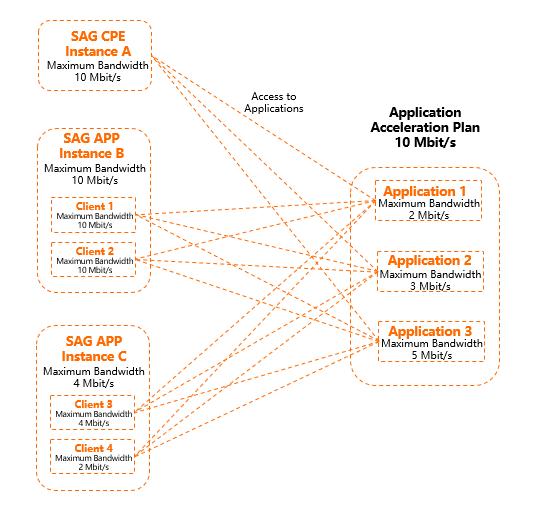An application acceleration plan can be shared by multiple on-premises networks that are associated with Smart Access Gateway (SAG) instances. To prevent on-premises networks associated with one SAG instance from consuming a large amount of bandwidth resources, the system allows you to throttle bandwidth from different dimensions. This way, you can use bandwidth resources for application acceleration more flexibly and effectively.
- Set a maximum bandwidth value for an SAG instance to specify the maximum bandwidth
that can be used by the associated on-premises networks for application acceleration.
The maximum bandwidth value of each SAG instance cannot exceed that of the associated application acceleration plan.
- Set a maximum bandwidth value for a client account of an SAG app instance to specify
the maximum bandwidth that can be used by the client account for application acceleration.
The maximum bandwidth value of each client account cannot exceed that of the SAG app instance to which the client account belongs.

For example, to accelerate access to Application 1, Application 2, and Application 3, you have purchased a 10 Mbit/s application acceleration plan. The application acceleration plan is associated with Instance A, Instance B, and Instance C, and the following configurations are made:
- The maximum bandwidth values for Application 1, Application 2, and Application 3 are set to 2 Mbit/s, 3 Mbit/s, and 5 Mbit/s.
- The maximum bandwidth values for Instance A, Instance B, and Instance C are set to 10 Mbit/s, 10 Mbit/s, and 4 Mbit/s.
- The maximum bandwidth values for Client 1, Client 2, Client 3, and Client 4 are set to 10 Mbit/s, 10 Mbit/s, 4 Mbit/s, and 4 Mbit/s.
This topic uses the following examples to help you understand the correlation between the maximum bandwidth value of each application.
At a point in time, only the on-premises networks associated with Instance A access Application 1. In this case, the maximum bandwidth that the on-premises networks can use is 2 Mbit/s.
At a point in time, the on-premises networks associated with Instance A and Client 2 access Application 1 at the same time. In this case, the sum of bandwidth used by the on-premises networks and Client 2 does not exceed 2 Mbit/s.
At a point in time, only Client 3 accesses Application 3. In this case, the maximum bandwidth that Client 3 can use is 4 Mbit/s because the maximum bandwidth of Client 3 is set to 4 Mbit/s.
Related operations
- Set a maximum bandwidth value for an SAG instance. For more information, see Associate an application acceleration plan with an SAG instance.
- Set a maximum value for the bandwidth of a client account. For more information, see Throttle bandwidth resources for a client account.
- Set a maximum bandwidth value for an application. For more information, see Manage an application acceleration rule.